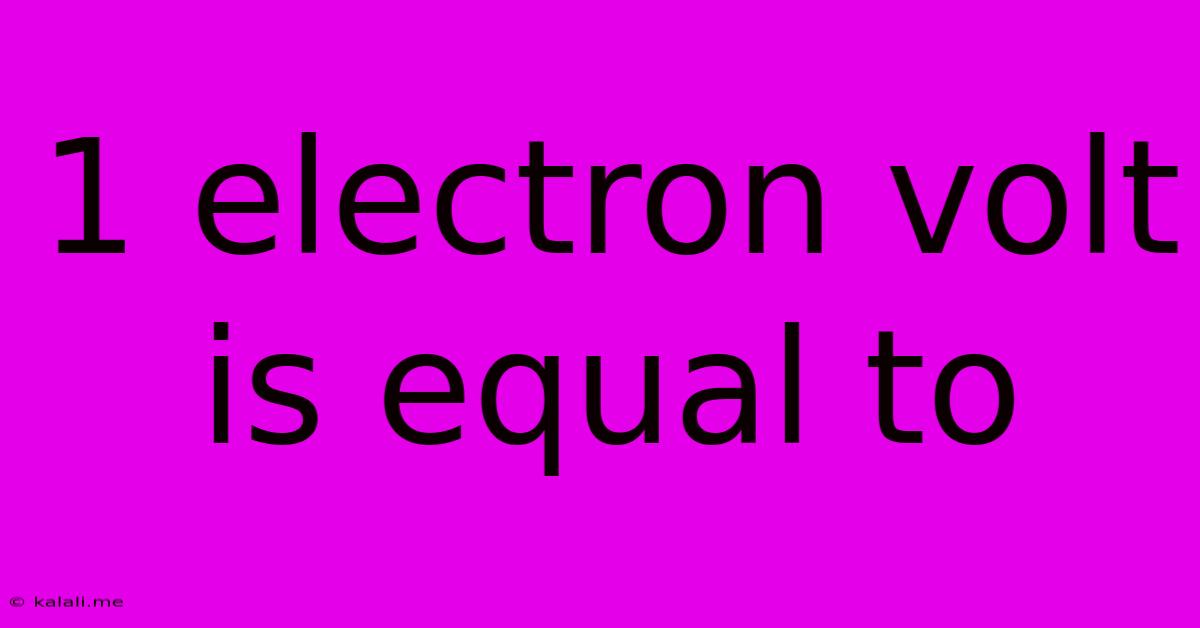1 Electron Volt Is Equal To
Kalali
Jun 15, 2025 · 3 min read

Table of Contents
1 Electron Volt is Equal To: Understanding Energy at the Atomic Scale
Meta Description: Confused about electron volts (eV)? This article explains what 1 electron volt is equal to in joules, its significance in physics, and its applications in various fields. Learn how this unit simplifies energy calculations at the atomic level.
The electron volt (eV) is a unit of energy commonly used in atomic, nuclear, and particle physics. While seemingly simple, understanding what 1 electron volt is equal to unlocks a deeper understanding of energy at the subatomic level. This unit isn't just a number; it represents the energy gained (or lost) by a single electron when it accelerates through an electric potential difference of one volt.
What is 1 Electron Volt Equal To in Joules?
The fundamental relationship lies in its conversion to joules (J), the standard unit of energy in the International System of Units (SI). 1 electron volt is equal to 1.602 x 10<sup>-19</sup> joules. This conversion factor is derived from the elementary charge of an electron (approximately 1.602 x 10<sup>-19</sup> coulombs) and the definition of a volt (joule per coulomb).
This seemingly tiny number highlights the incredibly small energies involved in atomic and subatomic processes. However, the eV's usefulness stems from its convenience in these contexts, avoiding cumbersome scientific notation often required when using joules directly.
Why Use Electron Volts?
Using joules to describe the energy of individual electrons or the interactions within atoms would result in extremely small and unwieldy numbers. The electron volt simplifies these calculations, providing a more manageable scale. Imagine trying to express the energy of a photon in a laser pointer using joules—the number would be minuscule and difficult to interpret. Expressing it in electron volts makes it much more intuitive.
Applications of Electron Volts
The electron volt finds application across numerous scientific disciplines:
- Atomic Physics: Describing the ionization energies of atoms, the energy levels of electrons within atoms, and other atomic processes.
- Nuclear Physics: Characterizing the energy released in nuclear reactions, such as fission and fusion.
- Particle Physics: Measuring the energy of particles accelerated in colliders, like protons in the Large Hadron Collider (LHC).
- Materials Science: Analyzing the band gaps in semiconductors and the energies of electrons within materials.
- Astrophysics: Studying the energy levels of atoms and ions in stars and other celestial objects.
Beyond the Basics: Understanding Energy Scales
The electron volt provides a convenient scale for understanding energy at various levels. For example:
- A few eV: Typical energies involved in chemical reactions and bond energies.
- Thousands of eV (keV): X-rays and gamma rays.
- Millions of eV (MeV): Energies in nuclear reactions.
- Billions of eV (GeV) and Trillions of eV (TeV): Energies of particles in high-energy physics experiments.
By understanding the equivalence of 1 electron volt and its applications, we gain a better grasp of the energy scales involved in the microscopic world, fostering a clearer understanding of the fundamental forces and processes that govern our universe. The seemingly small 1.602 x 10<sup>-19</sup> joules becomes a significant unit in the context of atomic and subatomic interactions.
Latest Posts
Latest Posts
-
Center Of Mass Of A Trapezoid
Jun 16, 2025
-
Did Rabindranath Tagore Refused Nobel Prize
Jun 16, 2025
-
The Difference Between Inference And Observation
Jun 16, 2025
-
Amine Vs Amide Vs Imine Vs Imide
Jun 16, 2025
-
Which Idea Was Supported By Both Plato And Aristotle
Jun 16, 2025
Related Post
Thank you for visiting our website which covers about 1 Electron Volt Is Equal To . We hope the information provided has been useful to you. Feel free to contact us if you have any questions or need further assistance. See you next time and don't miss to bookmark.